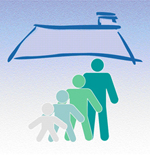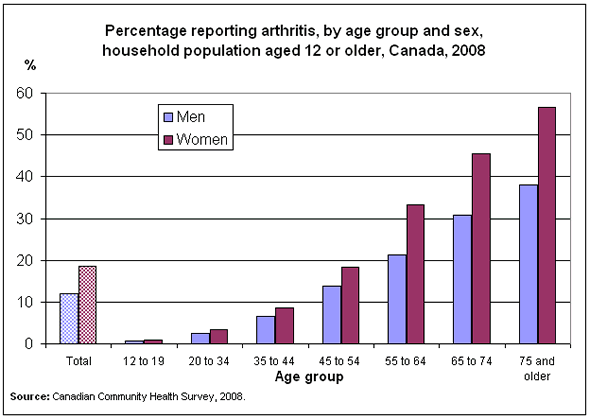Arthritis 2008
Archived Content
Information identified as archived is provided for reference, research or recordkeeping purposes. It is not subject to the Government of Canada Web Standards and has not been altered or updated since it was archived. Please "contact us" to request a format other than those available.

The term arthritis is used to describe many conditions that affect joints, the tissues surrounding joints, and other connective tissue. The most common types are osteoarthritis and rheumatoid arthritis. The resulting pain, stiffness, swelling and/or deformity of the joints can substantially reduce quality of life.
The data used here are based on a survey question that asked respondents if they had arthritis, excluding fibromyalgia.
In 2008, 15.3% of Canadians aged 12 or older reported that they had arthritis.
Among both sexes, the percentage reporting arthritis increases with age. Women were more likely than men to have arthritis in most age groups. The exceptions were ages 12 to 19 and 20 to 34, where differences between the sexes were not significant.
Chart 1

In 2008, 18.1% of rural dwellers reported being diagnosed with arthritis, compared with 14.7% of urban dwellers.
Quebec (11.2%), Alberta (14.2%), Yukon (11.3%), Northwest Territories (11.0%) and Nunavut (10.7%) reported arthritis rates lower than the national average. With the exception of British Columbia, rates in the other provinces were higher than the rate for Canada as a whole.
Because of the strong relationship between age and arthritis, a province or territory with a disproportionately high number of younger people would be expected to have an arthritis rate below the national average. The rate would tend to be high in a province or territory with a disproportionately large number of older residents. To remove the effect of different age distributions, the arthritis rates were recalculated as if the age groups in each province and territory were the same as at the national level. Based on these calculations, only Quebec had an arthritis rate lower than the rate for Canada. The rates in British Columbia, Prince Edward Island, Alberta, Yukon, Northwest Territories and Nunavut were not significantly different from Canada, and the arthritis rates in the other provinces were above the national rate.
Note: From 2001 to 2005 the survey question included rheumatism.
Source
Additional information from the Canadian Community Health Survey is available from CANSIM table 105-0501.
References
Hormone replacement therapy and incident arthritis. Wilkins K. 1999; 11(2): 49-57.
Incident arthritis in relation to excess weight. Wilkins K. 2004; 15(1): 39-49.
- Date modified:
